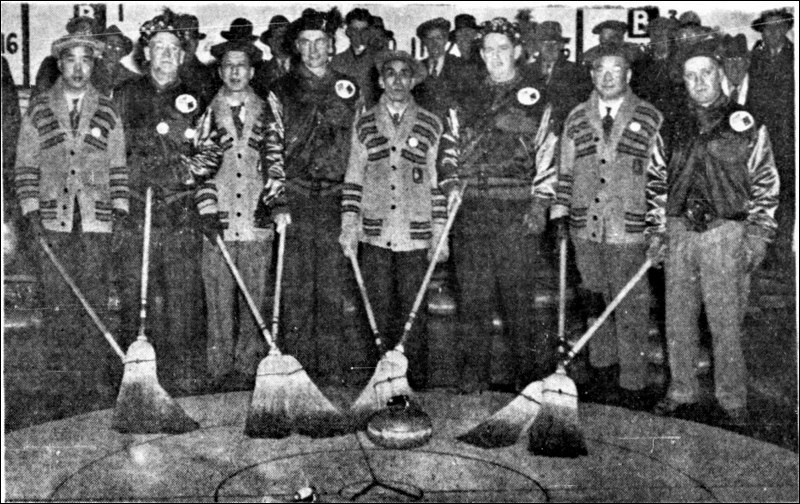As I research small-town Saskatchewan hotels, I often come across references to the men-only enclaves of Chinese laundry, restaurant and hotel owners that had settled in nearly every village, town and city in the province by 1919. These men, who were not allowed to bring their wives and children to Canada until 1947, did not have much time for leisure activities. Many of them did, however, participate in the sport of curling – whether as fans, team sponsors or as players.
In her book Cultivating Connections; The Making of Chinese Prairie Canada(2014), Allison R. Marshall writes that participation in sports provided lonely Chinese men the opportunity to connect with their neighbours. Curling, Marshall asserts, was the most significant sport in which prairie Chinese men and boys were welcome to participate. “As people watched local curling bonspiels that included Chinese curlers, they came to see these participants as members of their own community,” she writes.
There were several Chinese curlers in the province prior to 1950, but the most remarkable story I’ve come across is that of the all-Chinese rink from Wadena, skipped by Thomas (Tom) Sing. According to Canada census records, Sing arrived in Canada in 1906 at age 15. He went into the restaurant business at Wadena where he worked for 25 years before becoming the proprietor of the hotel in Elfros during the 1930s. By the 1940s, Sing was back running a restaurant in Wadena. Throughout the decades, he was a curler and his game just kept getting better and better.
On Feb. 14, 1927, according to the Regina Leader-Post, Sing entered an all-Chinese team in the Yorkton bonspiel. The other members of the rink were Toy Wing, George Hing, and Yuen Loy. They defeated a Manitoba team in their first game of the competition. “Did you ever see a Chinese curl?” Fred W. Graham asked in his Maclean’s magazine article entitled “Baled Hay Rinks” (Dec. 15, 1938). “I saw the [Wadena rink] in action at the Yorkton Bonspiel a few years ago. They always had the opposing rink advantage, for they discussed all their shots in their own language.”
In January of 1928, the Sing’s Wadena rink entered the Saskatoon bonspiel and scored a 9-6 win against a rink from Marengo in the T. Eaton competition for visiting rinks. “The Orientals played a splendid draw game and were in the lead all the way,” the Star Phoenix stated on Jan. 17. “The win proved most popular.”
In 1944, when Tom Sing was 53 years old, he entered the first-ever all-Chinese rink in the 56th annual Manitoba bonspiel. Curlers “blinked in surprise when they took to the ice this year,” Maclean’s wrote on March 15. Skipped by Sing (who was now back in Wadena), the rink included Toy Him of Wadena, Harry Ying (or Ing) of Preeceville, and Charlie Poy from Kelvington. None of them were young men. He and his team “curled for fun not for trophies,” Sing told Maclean’s. He likened curlers to bananas – green, yellow and overripe. His rink, he joked, was in the latter category.
Despite suffering some tough losses during the 1944 Manitoba bonspiel, Sing persevered. In 1945, he entered his rink in the 41st annual Saskatoon bonspiel – his first appearance in that ‘spiel since 1928. With 189 rinks competing, the Wadena curlers stole the show. An American vs Chinese game at the Granite Curling Club attracted one of the largest crowds in the bonspiel’s history. The Star Phoenix wrote: “In the early stages of the game the ice was too heavy for the Chinese boys, with the result they could barely reach the house with their shots. While these conditions existed, the Americans chalked up points and were leading 6-1 at the end of five ends. Mr. Sing went to town from then on. His men found the weight for draw shots and tied the score at 6-6 at the eighth end.” The final score was 11-8.
Curling provided a chance for Chinese Canadian men like Tom Sing to move out of the shadows and overcome stereotypes. Marshall cautions, however, that while sports participation “could help young Chinese men fit in, athletic involvement wasn’t a guarantee of acceptance.”



